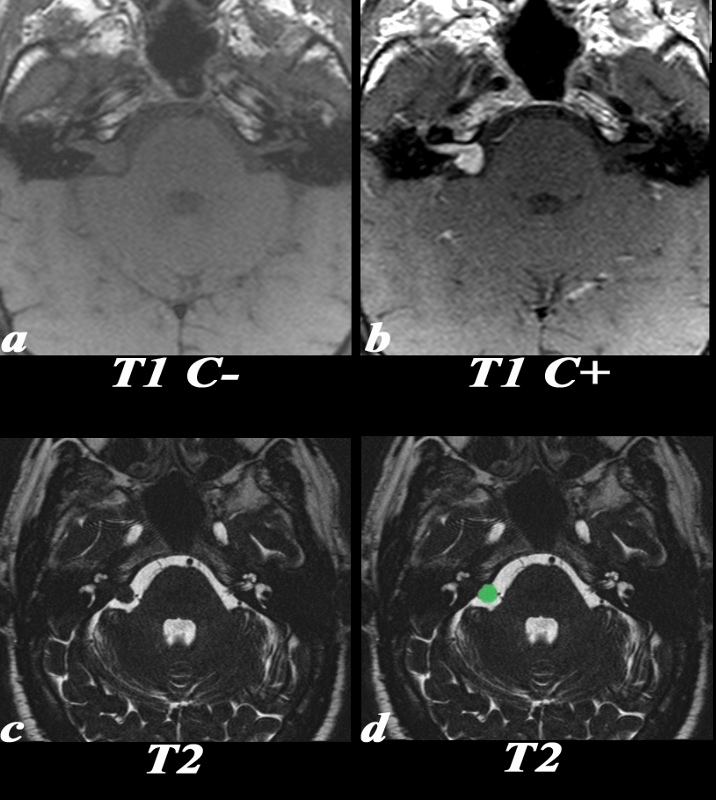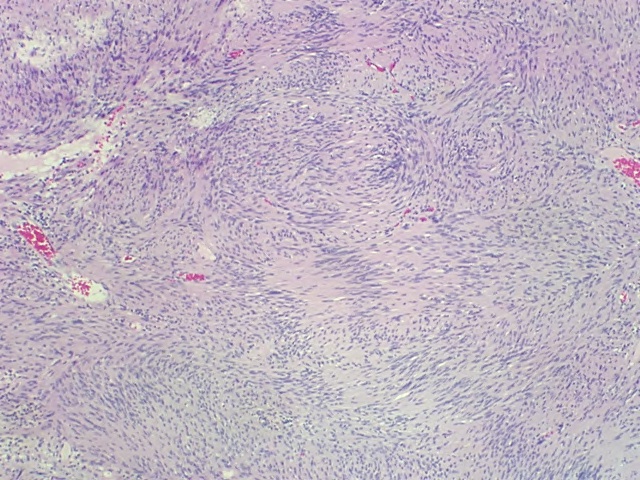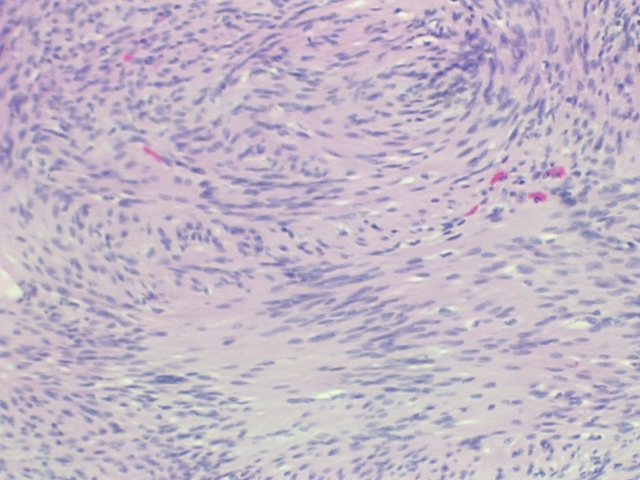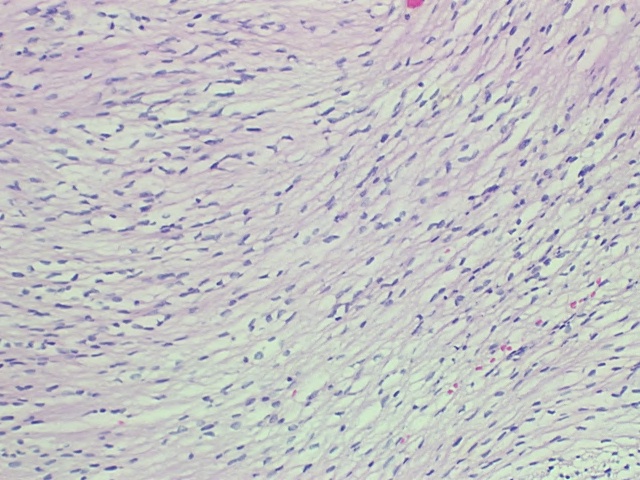Schwannoma
Elisa Flower MD and Asim Mian MD
The Common vein Copyright 2010
Definition
A Schwannomas is characterized as a benign tumor arising from the perineural Schwann cells.
They most often affect the vestibular division of cranial nerve VIII but can involve other cranial nerves as well, commonly the trigeminal or facial nerves. They are the second most common extra-axial mass in adults. Generally these are slow growing low grade tumors. Occasionally they may grow to be quite large and exhibit mass effect on the brainstem. Malignant degeneration is infrequent. Bilateral vestibular schwannomas are diagnostic of neurofibromatosis type two.
Histologically schwannomas are encapsulated masses attached to the nerve but can be dissected from it, unlike neurofibromas, another type of peripheral nerve sheath tumor. There are two classic growth patterns, Antoni A and Antoni B. In Antoni A there are densely packed elongated cells arranged in fascicles. The Antoni B pattern is made up of a loose meshwork of cells, microcysts and myxoid stroma.
Common symptoms of this tumor include sensineural hearing loss, vertigo and tinnitus.
Schwannomas can be imaged by CT however MRI is more sensitive for detection. On CT they appear isodense to the cerebellum. On MRI they may appear as a T1 isointense to hypointense and T2 hyperintense mass. Schwannomas enhance homogeneously, but may enhance heterogeneously and demonstrate areas of cystic degeneration and punctuate calcifications.
Treatment options include microsurgical resection or radiosurgery. Depending on patient symptoms and lesion size, they may be simply observed over time by serial imaging.

Acoustic Neuroma |
|
This 30 year old female presented with hearing loss on the right. T1: C- (a) The mass centered in the right internal auditory canal is isointense to the brain parenchyma. T1 post: C+ (b) This schwannoma enhances homogeneously and has the classic ?ice cream cone? shape. T2: On this high resolution T2 weighted image, there is loss of the normal fluid signal in the internal auditory canal which can be seen on the left. There is also a round component which projects into the cerebellopontine angle cistern. (overlaid in green in d) The findings are consistent with a Schwannoma or acoustic neuroma
Image Courtesy Elisa Flower MD and Asim Mian MD 97681c.8
|

H&E Low Power

H&E High Power

H&E High Power
Schwannoma |
|
These low and high power polymicrographs demonstrate the spindle cell proliferation identified within this schwannoma. The cells have almost a ?fish in stream? appearance, being lined up in the same direction. In some areas, the nuclei appear arranged in (dark) bands which alternate with nuclear free (or pink) areas, a pattern that has been called ?Verocay bodies.? These are seen more often in more cellular dense or Antoni A areas. The third polymicrograph is more characteristic of Antoni B with low cell density.
Image Courtesy of Cheryl Spencer, M.A. and Ivana Delalle, MD, PhD Department of Pathology Boston University School of Medicine 98521 98522 98523
|
References
Robbins Pathology
DOMElement Object
(
[schemaTypeInfo] =>
[tagName] => td
[firstElementChild] => (object value omitted)
[lastElementChild] => (object value omitted)
[childElementCount] => 2
[previousElementSibling] =>
[nextElementSibling] =>
[nodeName] => td
[nodeValue] =>
These low and high power polymicrographs demonstrate the spindle cell proliferation identified within this schwannoma. The cells have almost a ?fish in stream? appearance, being lined up in the same direction. In some areas, the nuclei appear arranged in (dark) bands which alternate with nuclear free (or pink) areas, a pattern that has been called ?Verocay bodies.? These are seen more often in more cellular dense or Antoni A areas. The third polymicrograph is more characteristic of Antoni B with low cell density.
Image Courtesy of Cheryl Spencer, M.A. and Ivana Delalle, MD, PhD Department of Pathology Boston University School of Medicine 98521 98522 98523
[nodeType] => 1
[parentNode] => (object value omitted)
[childNodes] => (object value omitted)
[firstChild] => (object value omitted)
[lastChild] => (object value omitted)
[previousSibling] => (object value omitted)
[nextSibling] => (object value omitted)
[attributes] => (object value omitted)
[ownerDocument] => (object value omitted)
[namespaceURI] =>
[prefix] =>
[localName] => td
[baseURI] =>
[textContent] =>
These low and high power polymicrographs demonstrate the spindle cell proliferation identified within this schwannoma. The cells have almost a ?fish in stream? appearance, being lined up in the same direction. In some areas, the nuclei appear arranged in (dark) bands which alternate with nuclear free (or pink) areas, a pattern that has been called ?Verocay bodies.? These are seen more often in more cellular dense or Antoni A areas. The third polymicrograph is more characteristic of Antoni B with low cell density.
Image Courtesy of Cheryl Spencer, M.A. and Ivana Delalle, MD, PhD Department of Pathology Boston University School of Medicine 98521 98522 98523
)
DOMElement Object
(
[schemaTypeInfo] =>
[tagName] => table
[firstElementChild] => (object value omitted)
[lastElementChild] => (object value omitted)
[childElementCount] => 1
[previousElementSibling] => (object value omitted)
[nextElementSibling] => (object value omitted)
[nodeName] => table
[nodeValue] =>
Acoustic Neuroma
This 30 year old female presented with hearing loss on the right. T1: C- (a) The mass centered in the right internal auditory canal is isointense to the brain parenchyma. T1 post: C+ (b) This schwannoma enhances homogeneously and has the classic ?ice cream cone? shape. T2: On this high resolution T2 weighted image, there is loss of the normal fluid signal in the internal auditory canal which can be seen on the left. There is also a round component which projects into the cerebellopontine angle cistern. (overlaid in green in d) The findings are consistent with a Schwannoma or acoustic neuroma
Image Courtesy Elisa Flower MD and Asim Mian MD 97681c.8
[nodeType] => 1
[parentNode] => (object value omitted)
[childNodes] => (object value omitted)
[firstChild] => (object value omitted)
[lastChild] => (object value omitted)
[previousSibling] => (object value omitted)
[nextSibling] => (object value omitted)
[attributes] => (object value omitted)
[ownerDocument] => (object value omitted)
[namespaceURI] =>
[prefix] =>
[localName] => table
[baseURI] =>
[textContent] =>
Acoustic Neuroma
This 30 year old female presented with hearing loss on the right. T1: C- (a) The mass centered in the right internal auditory canal is isointense to the brain parenchyma. T1 post: C+ (b) This schwannoma enhances homogeneously and has the classic ?ice cream cone? shape. T2: On this high resolution T2 weighted image, there is loss of the normal fluid signal in the internal auditory canal which can be seen on the left. There is also a round component which projects into the cerebellopontine angle cistern. (overlaid in green in d) The findings are consistent with a Schwannoma or acoustic neuroma
Image Courtesy Elisa Flower MD and Asim Mian MD 97681c.8
)
DOMElement Object
(
[schemaTypeInfo] =>
[tagName] => td
[firstElementChild] => (object value omitted)
[lastElementChild] => (object value omitted)
[childElementCount] => 2
[previousElementSibling] =>
[nextElementSibling] =>
[nodeName] => td
[nodeValue] =>
This 30 year old female presented with hearing loss on the right. T1: C- (a) The mass centered in the right internal auditory canal is isointense to the brain parenchyma. T1 post: C+ (b) This schwannoma enhances homogeneously and has the classic ?ice cream cone? shape. T2: On this high resolution T2 weighted image, there is loss of the normal fluid signal in the internal auditory canal which can be seen on the left. There is also a round component which projects into the cerebellopontine angle cistern. (overlaid in green in d) The findings are consistent with a Schwannoma or acoustic neuroma
Image Courtesy Elisa Flower MD and Asim Mian MD 97681c.8
[nodeType] => 1
[parentNode] => (object value omitted)
[childNodes] => (object value omitted)
[firstChild] => (object value omitted)
[lastChild] => (object value omitted)
[previousSibling] => (object value omitted)
[nextSibling] => (object value omitted)
[attributes] => (object value omitted)
[ownerDocument] => (object value omitted)
[namespaceURI] =>
[prefix] =>
[localName] => td
[baseURI] =>
[textContent] =>
This 30 year old female presented with hearing loss on the right. T1: C- (a) The mass centered in the right internal auditory canal is isointense to the brain parenchyma. T1 post: C+ (b) This schwannoma enhances homogeneously and has the classic ?ice cream cone? shape. T2: On this high resolution T2 weighted image, there is loss of the normal fluid signal in the internal auditory canal which can be seen on the left. There is also a round component which projects into the cerebellopontine angle cistern. (overlaid in green in d) The findings are consistent with a Schwannoma or acoustic neuroma
Image Courtesy Elisa Flower MD and Asim Mian MD 97681c.8
)
DOMElement Object
(
[schemaTypeInfo] =>
[tagName] => td
[firstElementChild] => (object value omitted)
[lastElementChild] => (object value omitted)
[childElementCount] => 2
[previousElementSibling] =>
[nextElementSibling] =>
[nodeName] => td
[nodeValue] =>
Acoustic Neuroma
[nodeType] => 1
[parentNode] => (object value omitted)
[childNodes] => (object value omitted)
[firstChild] => (object value omitted)
[lastChild] => (object value omitted)
[previousSibling] => (object value omitted)
[nextSibling] => (object value omitted)
[attributes] => (object value omitted)
[ownerDocument] => (object value omitted)
[namespaceURI] =>
[prefix] =>
[localName] => td
[baseURI] =>
[textContent] =>
Acoustic Neuroma
)




